
Arequipa Travel Guide & Itinerary (+ Map) – Peru’s White City
TL;DR
Discover why the “White City” should be on your Peru itinerary with our ultimate Arequipa Travel Guide – packed with top sights, hidden gems, and unforgettable day trips.
If you’re planning a trip through Peru and wondering whether Arequipa deserves a spot on your itinerary, you’re in the right place.
Travelers often focus on Cusco and Machu Picchu – missing Arequipa because they think it’s “just another city.” Or they stop over without realizing how much there is to see, from volcanic landscapes to colonial charm and yummy cuisine.
After exploring the White City ourselves – wandering its streets and alleys, tasting queso helado, and taking in jaw-dropping views of Misti Volcano, we’ve put together everything you need to plan the perfect visit. From free attractions to epic day trips like Colca Canyon, this guide covers it all.
Whether you’re a backpacker chasing adventure, a couple looking for a romantic escape, or a cultural traveller eager to dive into local history, Arequipa offers a little something for everyone. We fell in love with Arequipa’s relaxed vibe, sunshine, and endless views – and we’re confident you will too. Let’s dive into why this “White City” is one of Peru’s brightest gems.
Arequipa Travel Guide
Arequipa Map
Is Arequipa Worth Visiting?
Arequipa is many things: It is called the “White City” because many of its houses are built with white volcanic stone, called sillar. In addition, it is known for its volcanoes, first and foremost Misti, which towers over the city.
As the second-largest city in Peru, Arequipa is also the commercial, political, and military center of southern Peru. It might sound like a contrast, but a fellow traveller told us that they thought Arequipa was the most romantic city in Peru, and we are inclined to agree.
And last but not least, Arequipa is the perfect base to explore Colca Canyon, one of the deepest canyons in the world.
So yes, yes, Arequipa is 100% worth visiting. It captures the perfect blend of natural beauty, rich history, and vibrant culture that makes it unforgettable.
Where We Stayed in Arequipa
We stayed at Park Hostel, which was a budget-friendly and central accommodation. The views from the rooftop, where you can relax and the free breakfast is served, are amazing. You can also use the shared kitchen and enjoy your own meals on the terrace.
We could store our luggage for free both before and after the night bus.
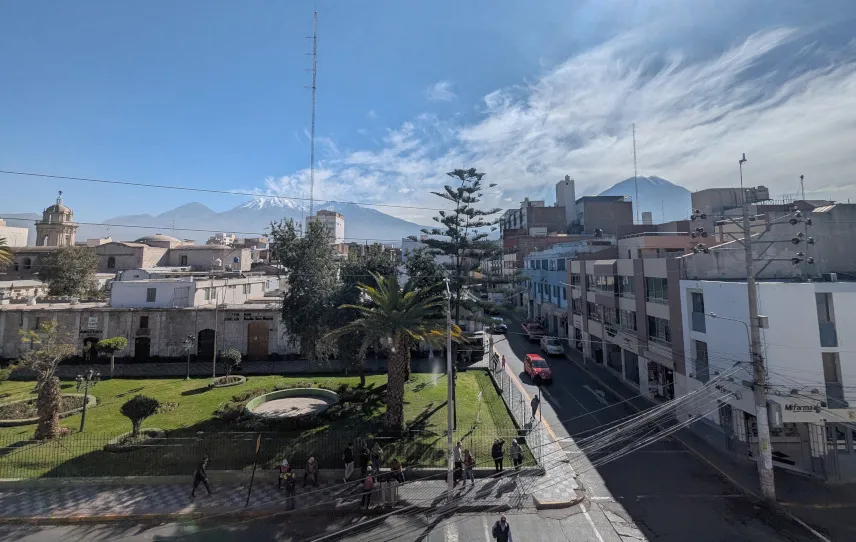
How to Get to Arequipa
As Arequipa is the second largest city in Peru, it is well connected by bus to all major destinations like:
There’s also a national airport with flights to Lima and Cusco:
How to Get Around Arequipa
The city centre is very walkable.
For further distances, e.g., to the bus terminal, Uber is probably your most convenient option.
12 Amazing Things to Do in Arequipa
1. Free Walking Tour
You probably know that we love to start a stay in a new city with a free walking tour, and Arequipa was no different. We chose this Free Walking Tour Arequipa City and can fully recommend it. We visited the most important sights of Arequipa and also got to know some hidden gems.
In the following paragraphs, we’ll give you an overview of all major points of interest in case a guided tour is not for you.
2. Plaza de Armas & Basilica Catedral of Arequipa
The Plaza de Armas is the founding place of the city. It is located in the historic centre and surrounded by the Arequipa Cathedral to the north, the Arequipa Portals to the east, southeast, and west, the La Compañía Church to the southeast, the Nuestra Señora de la Merced Church to the southwest, and a bronze fountain in the centre of the plaza.
The Basilica Cathedral of Arequipa is the most important Catholic church in the city and is also considered one of Peru's most unusual and famous colonial cathedrals since the Spanish conquest.
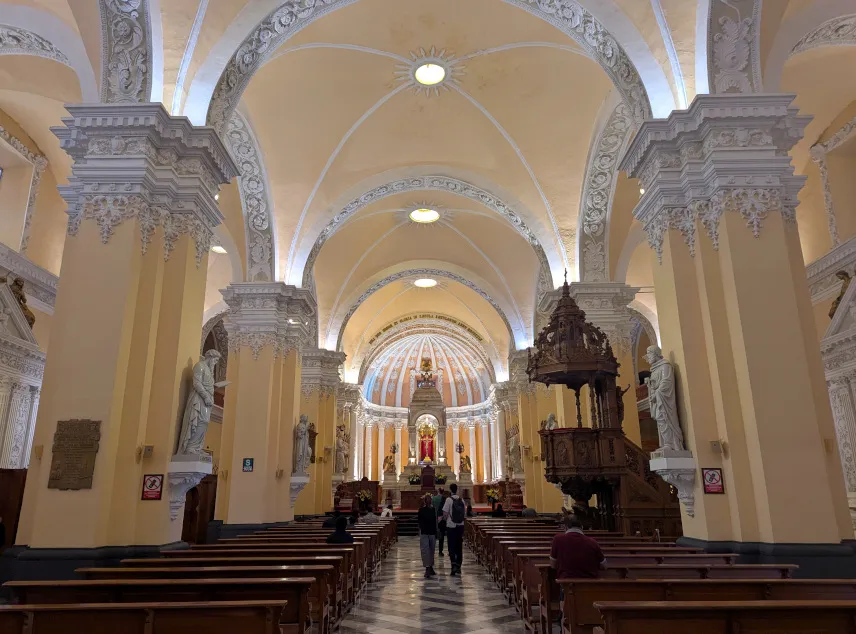
3. Iglesia & Claustros de la Compañía
The Iglesia de la Compañía or Church of the Company is one of the most outstanding examples of so-called Andean Baroque architecture. Don’t miss the stunning facade!
Inside the church, you can see carved wooden altarpieces covered with gold leaf.
The Claustros de la Compañía or Cloisters of the Company were built in the 18th century. They are adorned with intricate relief works. Nowadays, they house shops and cafes.
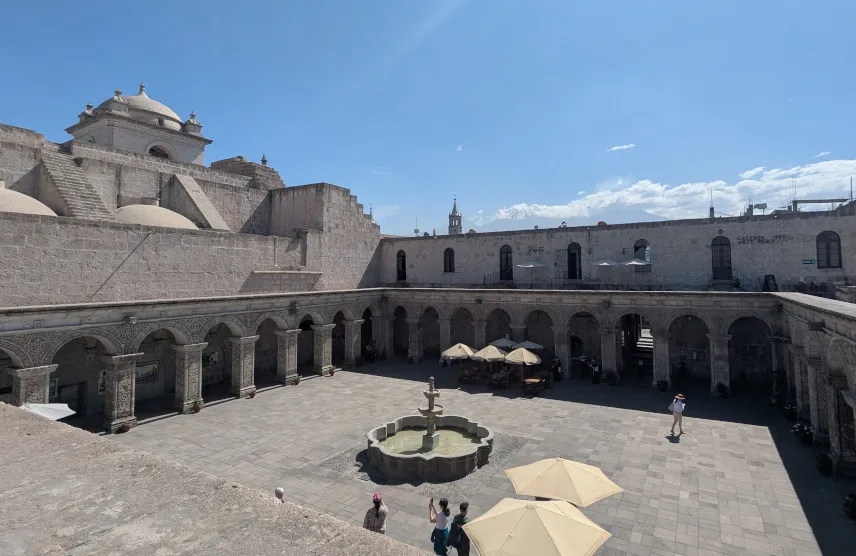
4. Casa Tristan del Pozo
Casa Tristan del Pozo is a beautiful colonial mansion (casona) converted into an art gallery. The gallery is free to enter and displays works from painters of the local Arequipeña school.
5. Calle Mercaderes
Calle Mercaderes is one of the city's main commercial streets. It’s a busy pedestrian promenade with many shops. The street starts next to the Plaza de Armas, and runs for several blocks until reaching a lovely small square with several trees and benches that allow for a nice rest.
Some of the most noteworthy buildings include the theatre and the Banco Internacional del Perú.
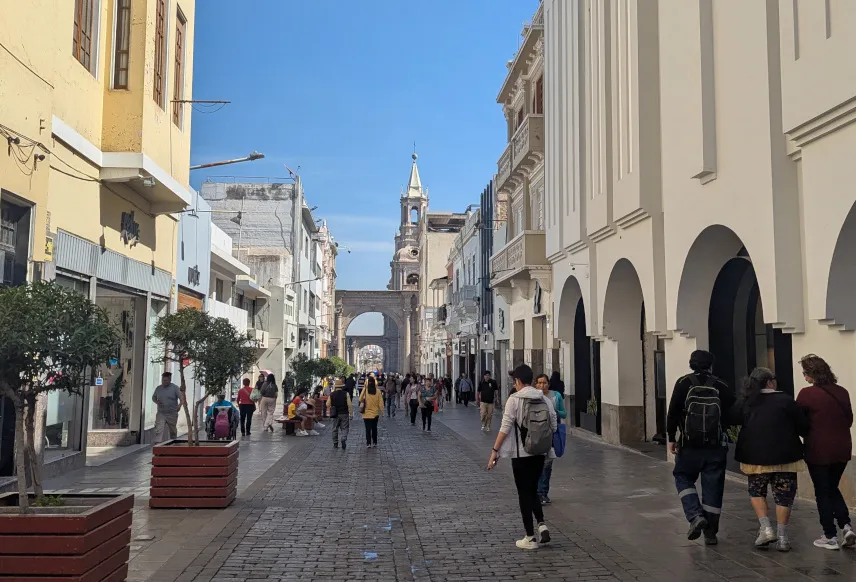
6. Wonder Around
We found Arequipa a particularly pleasant place to just wander around. The tiny Pasaje Cañon, as well as the Pasaje de la Catedral, full of restaurants, are particularly lovely.
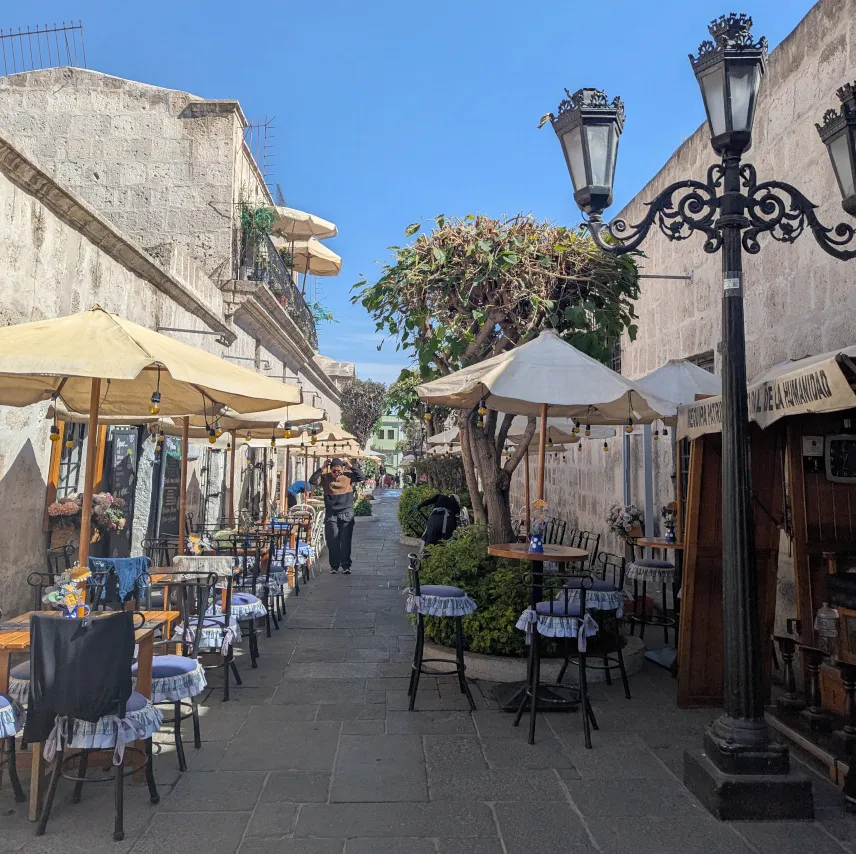
7. Monasterio de Santa Catalina
Tucked away in the heart of Arequipa, the Monasterio de Santa Catalina is one of Peru’s most fascinating and beautiful historical sites.
Founded in 1579 by Doña María de Guzmán, this vast convent of the Dominican Order is often described as a “city within a city,” covering over 20,000 square meters (2,152,782 square feet) of winding cobblestone streets, colourful courtyards, and serene cloisters.
Built from Arequipa’s signature white volcanic stone, sillar, Santa Catalina blends Colonial, Mestizo Baroque, and Neoclassical styles, creating a vibrant maze of blue, red, and ochre walls adorned with flowers.
For centuries, it remained cloistered from the world, home to hundreds of nuns from noble families. Today, part of the monastery remains active, while the rest welcomes visitors to explore its preserved kitchens, laundry area, art galleries, and chapels filled with paintings.
8. Mundo Alpaca
According to their own words, "Mundo Alpaca is […] seeking to expose and promote the textile richness of Peru and the Andes and to live, up close, the experience of the Alpaca and its millenary history.”
There’s an Alpaca experience where you can interact directly with these animals. In addition, there’s a live demonstration of the manufacturing processes as well as a small exhibition.
Of course, you can also buy Alpaca products in their shop.
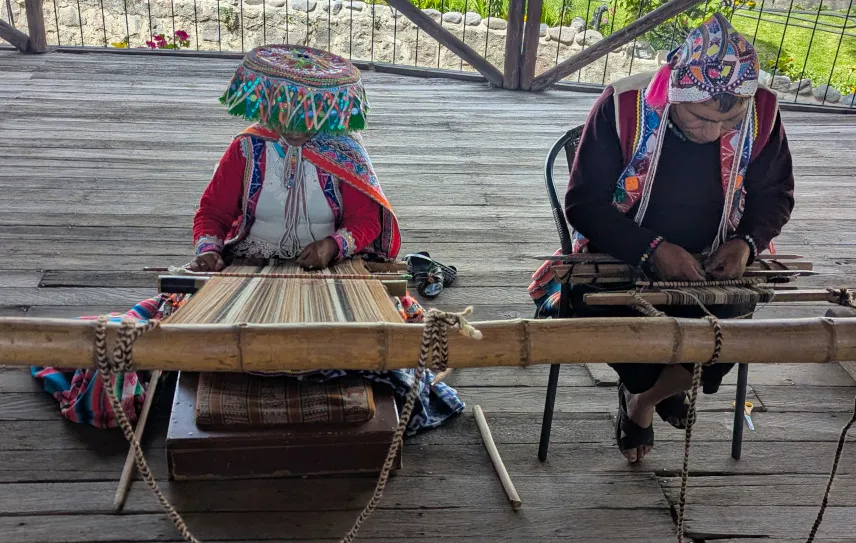
9. Mirador Yanahaura
Mirador Yanahaura is probably the most famous viewpoint in Arequipa. It’s a short and pleasant walk uphill from the city centre.
Through the arches of the viewpoint, you can spot Misti Volcano. They were packed with people taking photos when we visited. There are also a lot of vendors.
Right next door, there’s the lovely Parroquia San Juan Bautista de Yanahuara church.
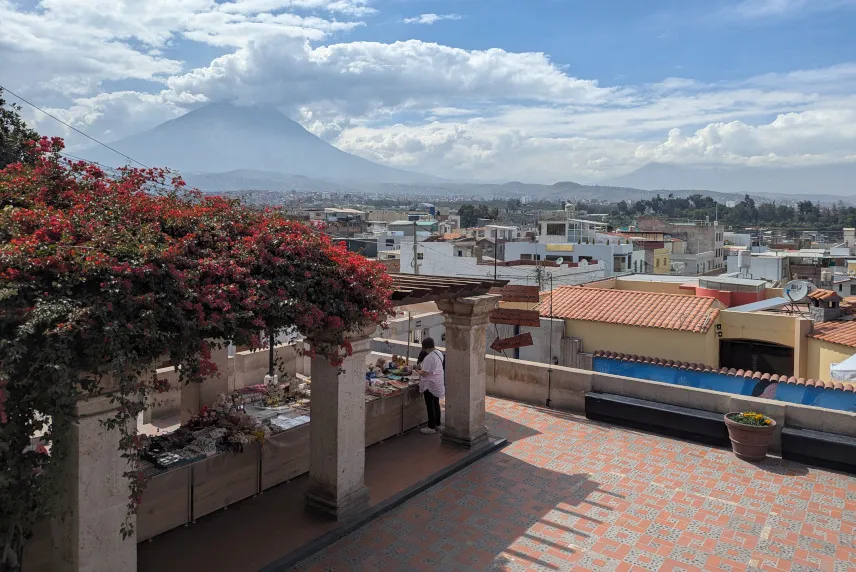
10. Rooftop Views
Arequipa is full of lovely rooftop terraces with views of the city and Misti Volcano. Our favourites were from our hotel, Ariquepay Hotel Boutique, and Eco Brunch.
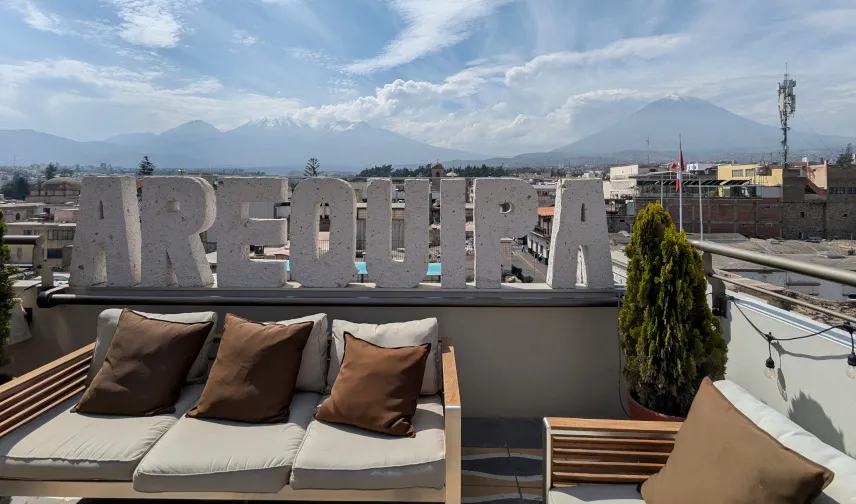
11. Mercado San Camilo
The San Camilo Market is a lively hub of colour, flavour, and tradition. The market was inaugurated in 1938 and later declared a Monumental Historical Heritage site. Inside its bustling aisles, you’ll find everything from fresh produce and flowers to handmade crafts and local delicacies. Don’t miss trying rocoto relleno or adobo, two of Arequipa’s signature dishes!
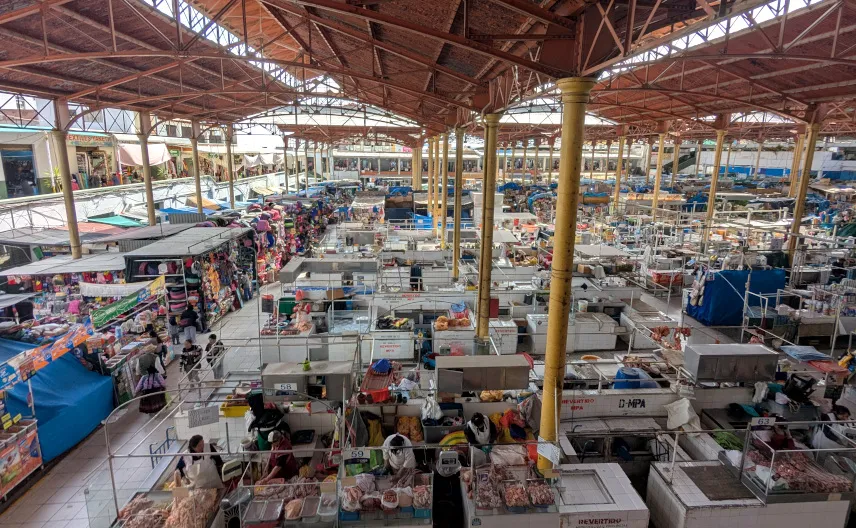
12. Fundo El Fierro
If you’re looking for authentic souvenirs and a glimpse into Arequipa’s artisanal culture, Fundo El Fierro is a must-visit. Located near Plaza San Francisco, this historic estate now houses the Guillermo Zegarra Meneses Municipal Historical Museum and the Artisan Producers Association, where around 50 artisans from across Peru showcase handmade textiles, jewellery, leather goods, ashlar crafts, and more.
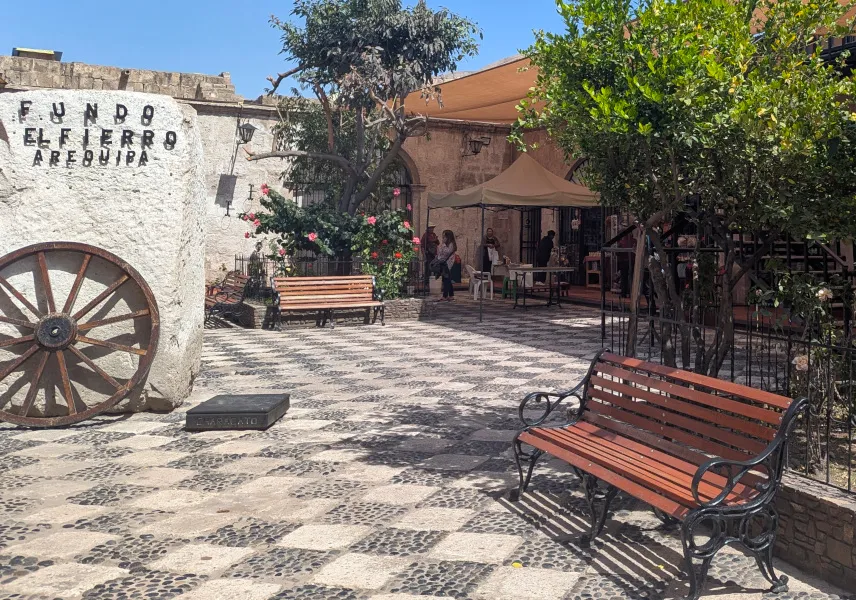
Best Tours from Arequipa
1. Day Trip to the Colca Canyon
We went on a Colca Canyon Full-Day Guided Tour and can fully recommend it. On this tour, you can see the best of what Colca Canyon has to offer in just one day:
- See volcanoes at Mirador de Patapampa.
- Spot condors at the Cross of the Condor.
- Visit beautiful, typical towns like Yanque and Maca.
- Soak in the hot springs of Yanque.
- See alpacas and vicuñas at the Salinas y Aguada Blanca National Reserve.
You can book this tour on both Viator and GetYourGuide. Feel free to compare both for the best offer.
We have written a full review of our day tour to the Colca Canyon:
2. Sillar Route Trek
The Sillar Route is a fascinating half-day trip that takes you through the origins of the city’s iconic white volcanic stone, sillar, which gives Arequipa its name, the “White City”.
Starting in the morning, you’ll head toward the Añashuayco Quarry, where local stonemasons still carve the same sillar used to build Arequipa’s colonial houses and churches. Here, you can admire towering canyon walls, see intricate stone carvings, and even try cutting a block yourself.
The journey continues to Quebrada de Culebrillas, a narrow canyon shaped by water and time, where ancient Wari petroglyphs and mystical Apachetas (stone offerings to nature) await.
By early afternoon, you’ll return to the city with a new appreciation for the stone that gave Arequipa its nickname.
3. Salinas Lagoon and National Reserve
The third popular half-day trip from Arequipa is an in-depth visit to the Salinas Lagoon and National Reserve. After breakfast in the town of Chiguata, the journey winds up to the Mirador de los Volcanes, offering sweeping views of the region’s majestic peaks.
By midmorning, you’ll reach the breathtaking Salinas Reserve, where vast white salt flats and shimmering Salinas Lagoon create surreal mirror-like reflections – perfect for photos.
The adventure continues with a visit to a High Andean camelid and bird reserve, where you can spot alpacas, vicuñas, flamingos, and more.
Those who wish can take a relaxing dip in the mini thermal wells before heading back to Arequipa by early afternoon.
4. Adventure Activities
We didn’t try any of these adventure activities in Arequipa, but wanted to include them for the sake of completeness:
5. 2-Day Trek in the Colca Canyon
Hiking enthusiasts can opt for a 2-day trek in the Colca Canyon, which either ends in Arequipa or Puno.
Where to Eat in Arequipa
We really enjoyed the food in Arequipa – both the amazing traditional options and the Western cuisine. Here are our favourites:
- Picanteria La Mundial for traditional food.
- Mercado San Camilo for traditional food.
- Street food vendors all around the city for queso helado ("frozen cheese," a typical Arequipan dessert that does not contain cheese but fresh and condensed milk).
- Eco Brunch for brunch with a view.
- Ariquepay Hotel Boutique for drinks with a view.
- La Canasta for a snack.
- Coffee roaster - Kaffeehaus if you’re craving your German fix (ok, maybe that’s just us).
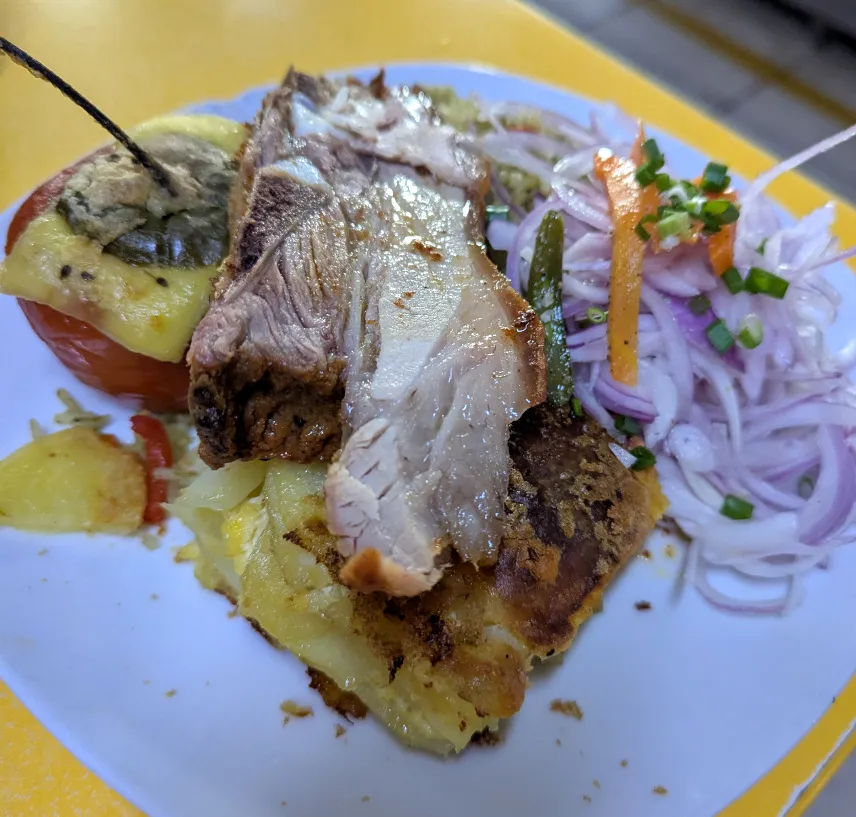
How Many Days in Arequipa Do You Need
Even if you’re short on time, we recommend spending at least two days in Arequipa: One for the city itself and another for one of the spectacular day trips.
Arequipa Itinerary
Day 1 – Free Walking Tour & Centro Historico
Start your day with a free walking tour and visit the remaining sights from our “12 things to do in Arequipa” list (see above) that pique your interest in the afternoon!
Day 2 – Day Trip
If you don’t plan to do a multi-day trek, we highly recommend a day trip to the Colca Canyon.
The Sillar Route and the Salinas Lagoon and National Reserve are great alternatives / additions if you have more time!
Arequipa Tips
ATMs in Arequipa
Arequipa is the second biggest city in Peru. You should have no problems finding an ATM.
Supermarkets in Arequipa
There are some supermarkets dotted around Arequipa. Our favourite was El Súper at Plaza de Armas.
Internet in Arequipa
We had great internet both in our accommodation and with our eSIM card.
Is Arequipa Safe
Like in many major cities, we recommend using extra caution. Don’t walk around at night, prefer Uber over regular taxis, don’t flash your valuables, and keep your belongings safe.
This post contains affiliate links. If you use these links to buy something we may earn a commission. You would help us a lot if you do so. Thanks.
